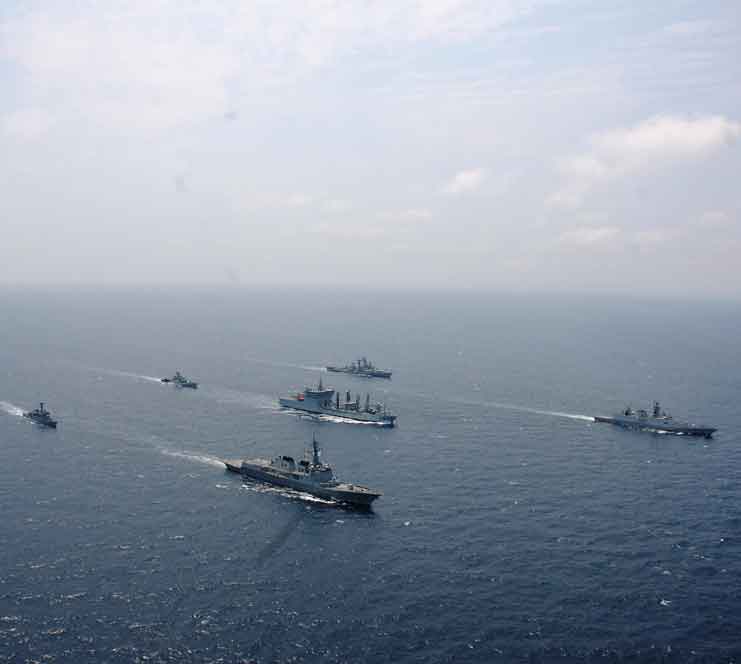Ships are built in the shortest time when a series of specific pre-planned Modules are assembled like a Lego set. A Module is an engineered assembly of a portion of the ship Platform that contains a set of concentrated hardware and software that drives one or more specific functions of the ship directly or in combination with other Modules. The rapid growth of related sciences during the last two decades makes it practical for stand-alone Modules to be designed and built independently and then assembled to form a complete ship.
Modules and the Blocks that follow are built to very tight and exacting tolerances. They are continuously monitored during construction and assembled to form the Platform at exact positions using laser trackers.
Typical Modules for a warship are Command and Control, Underwater Weapons, Underwater sensors, Surface weapons, Surface sensors, Communication, Main Propulsion, Auxiliary Machinery, Accommodation, Liquids etc. Modular design can also accommodate a process called Technology Update (TU) to implement advanced technologies as they become available. This enables the designer to incorporate both evolutionary and revolutionary technologies at the component, system, and Module levels. Mast mounted electro-optical sensors, environmental sniffers, communications, sonar etc are continuously being improved. TU allows for the original parent Module to incorporate such new refinements as pre packaged bundles at an opportune time.
The construction time is least when the Modules in turn are preassembled into Blocks. A Block consists of a set of adjacent linked Modules with all the associated steel work. A principal Module supplier is usually the designate for assembling the Block. Where this is impossible, such assembly must then be done at the Platform site. The size of this Block depends on the handling, storage, assembly arrangements and the proximity of the module suppliers. The assembly of the Platform is fastest when the number of Blocks is small. Examples of typical Modules and Blocks may be seen in Figures 1 to 11 shown herein.
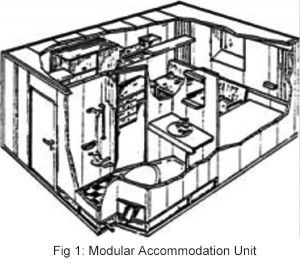 Modules and the Blocks that follow are built to very tight and exacting tolerances. They are continuously monitored during construction and assembled to form the Platform at exact positions using laser trackers. Dimensional accuracy is a key requirement of Modular construction. Because of that, welding distortions need to be controlled and strategies devised to mitigate any distortions and residual stress that will affect the final assembly of the Platform. The library of documented procedures, shell contour allowances and 3-d nodal distortions for each Module/Block at each Builder’s site and the precise environ conditions need to be reviewed as part of the qualifying tests. In the case of sub sea cylinders and spheres, the swing arc frame, theodolite, electro-levels that were used for circularity measurements are now redundant. Circularity measurement rate has been speeded up ten fold and more by using the portable 3-d coordinate measuring portable scanner with its laser mouse on a triangular Platform supported on three ball rollers. It is held against the inspection surface of the cylinder or sphere by magnetic force. It has its own wireless output and is an excellent replacement with far better four digit accuracy.
Modules and the Blocks that follow are built to very tight and exacting tolerances. They are continuously monitored during construction and assembled to form the Platform at exact positions using laser trackers. Dimensional accuracy is a key requirement of Modular construction. Because of that, welding distortions need to be controlled and strategies devised to mitigate any distortions and residual stress that will affect the final assembly of the Platform. The library of documented procedures, shell contour allowances and 3-d nodal distortions for each Module/Block at each Builder’s site and the precise environ conditions need to be reviewed as part of the qualifying tests. In the case of sub sea cylinders and spheres, the swing arc frame, theodolite, electro-levels that were used for circularity measurements are now redundant. Circularity measurement rate has been speeded up ten fold and more by using the portable 3-d coordinate measuring portable scanner with its laser mouse on a triangular Platform supported on three ball rollers. It is held against the inspection surface of the cylinder or sphere by magnetic force. It has its own wireless output and is an excellent replacement with far better four digit accuracy.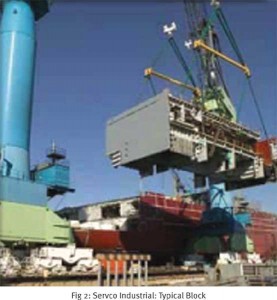
Lots of studs are required on a new Platform for supporting and securing shell/deck mounted equipments and rafts. Using a laser image projector and a data scanner on the vessel’s computer aided design (CAD) base, the locations for the studs on a new hull are automatically spotted thus eliminating thousands of hours wasted in 3-D measurements by hand. The use of mice in shipbuilding has exploded. Earlier we had a twin roller, ball mouse. The infra red mouse killed that and the laser mouse followed soon after. All that happened in seven years. The Naval High Command has consistently highlighted the slow rates of deliveries of warships. Yet, nothing substantial has been done to achieve the desired productivity.
Modular design of a Warship is very different from conventional design. It is more complex because the design algorithm is raised to a much higher level. The problem now condenses to designing and assembling a warship that will meet the Statement of Requirements using the least number of standalone Modules whilst also restricting the overall weight and volume. In conventional design, the reference to Modules and their numbers is of little concern to the designer. Because of this, the number of resultant pre assemblies is far from the optimum and have no accountability. In Modular design, the required redundancies and system fail safe levels need to be decided very early as re-engineering to meet late stage demands is wasteful.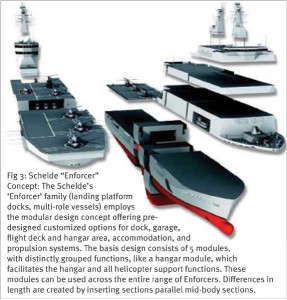
Modular assembly generates the fastest building times. The productivity heavily depends on the design philosophy used to minimize the number of Modules and the associated discipline of the designers. It is also closely related to the size, the independence and integrity of each Module achieved prior to its assembly to create the Platform. The framework of our Shipbuilding and Defense industry, as an entity, was formulated in the last century. During that time, ships were not designed on the basis of strict segregation of functions which process requires them to have their own dedicated space allocations. Instead, functions invariably spilt over to many locations all over the Platform on a “locate as best” principle within the permissible bounds of stability. Further, the industry as a whole had little inbuilt capacity for any innovation and evolution essential for faster deliveries. It vigorously promoted a dependence on outside consultants for such changes and still continues.
Designers of video games of the late 1970’s like Space Invaders, were the first to prove the versatility of the concept of large scale Modular design and construction when applied to space warfare in real time using computers. As processors became more powerful, newer games became even more complex. A mother ship could now seamlessly remove or patch on Modules for defense, attack, command and control, power, fuel etc. Many of these were developed independent of the main franchise. Rival players of Star Trek were able to load Modules of their choice to optimize their chosen strategies which made the game even more interesting. It should always be remembered that a Module is an independent assembly of engineering hardware and software to perform a given function given a set of design inputs and constraints. With the construction in space of the International space station, Modular design, construction and assembly is now a reality that captivates all of us.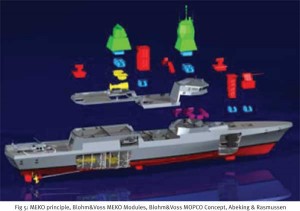
All living beings come into existence through natures principle of Modular design and building. We are all built from a single embryonic stem cell. That cell contained within the inner layer of the blastocyst has the ability to replicate itself or transform themselves to specialized cells for specific body parts like the liver, the eye, bones etc. It should be remembered that a typical cell weighs 1 nano gram and is 1 uM long. Within that cell, there are thirteen distinct bio-systems; all alive and in communication with each other based on enzymes and histones internally and externally. The DNA, the RNA and the Epigenes are the instruction set in each cell. There is much to be learnt from the simplicity used by nature the Master Builder that has produced many billions of different humans. It provides great reliability, is cheap and repetitive. It always starts off with an inventory or catalogue of all the basic structures it needs before it proceeds further.
Likewise, the Modular design and construction of Warships too requires certain basics. These are:
- A common base catalog of information that can be used repeatedly throughout the industry. Currently, this does not exist.
- Two or more specialist Module designers who have the required expertise and experience in certain types of Modules.
- Platform designers who can interface with the Module designers to create the ship.
- Module builders who specialize in building the Modules designed and can deliver the same to the Assembly yard either as standalone modules or assembled into Blocks that contain adjacent Modules also built nearby.
- The Assembly Shipyard is the Yard who principally stores and assembles the Modules or Blocks supplied by others but also has the capacity to participate in the design and building of certain Modules or Blocks if required.
- A standalone fully independent project Office who manages the project which includes the Module designers, the Platform designers, the Module builders and the Platform assembly yard. In addition, it should conduct all inspections, tests trials, delivery and post delivery. It is recommended that this Office be also exclusively responsible for configuration management and the cost of each ship of the class on a womb to tomb basis.
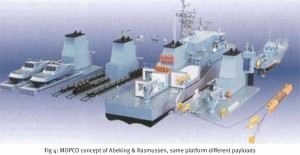 Like in nature, it is absolutely necessary to first establish an electronic Common Base Catalog (CBC) of all Objects to be used. The Objects, using a top down approach from the base Platform, are its systems, subsystems and components inclusive of their dependency and inter relationship with other Objects. The development of a structured catalog though time intensive initially, in conjunction with CAD drastically reduces the time spent on Module and Platform design. The compilation of the CBC is no easy task. Nevertheless, being the world’s leader in software applications, such a task is well within the nation’s capacity. In brief, the CBC will have in electronic format every Specification, drawing, technical data, operations, maintenance, end of life disposal instructions and costing data pertaining to any item used in shipbuilding and relevant to other items during its life. The creation of a CBC could take upto four years as it involves creating a hierarchy of classes containing over twenty million objects each having nearly a hundred and fifty attributes. In addition, many of these objects have to be linked thru interfaces and mapping functions to other data sets such as their supply chain sources, handling & logistics, warehousing requirements, maintenance and disposal etc. The data set must also include all inspection, tests and trials including applicable vibration, noise, shock, thermal, radar imaging and ashore trials required. These have to be jointly established and agreed to by all concerned partners such as the Platform, Module designers, Module Builders, Ship builders and suppliers.
Like in nature, it is absolutely necessary to first establish an electronic Common Base Catalog (CBC) of all Objects to be used. The Objects, using a top down approach from the base Platform, are its systems, subsystems and components inclusive of their dependency and inter relationship with other Objects. The development of a structured catalog though time intensive initially, in conjunction with CAD drastically reduces the time spent on Module and Platform design. The compilation of the CBC is no easy task. Nevertheless, being the world’s leader in software applications, such a task is well within the nation’s capacity. In brief, the CBC will have in electronic format every Specification, drawing, technical data, operations, maintenance, end of life disposal instructions and costing data pertaining to any item used in shipbuilding and relevant to other items during its life. The creation of a CBC could take upto four years as it involves creating a hierarchy of classes containing over twenty million objects each having nearly a hundred and fifty attributes. In addition, many of these objects have to be linked thru interfaces and mapping functions to other data sets such as their supply chain sources, handling & logistics, warehousing requirements, maintenance and disposal etc. The data set must also include all inspection, tests and trials including applicable vibration, noise, shock, thermal, radar imaging and ashore trials required. These have to be jointly established and agreed to by all concerned partners such as the Platform, Module designers, Module Builders, Ship builders and suppliers.
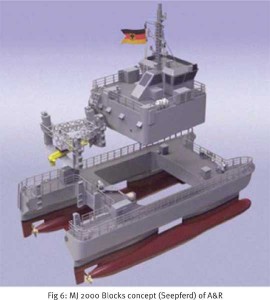 With a CBC in place, it now becomes practical for designers to specialize either in the design of a particular type of Module such Command and Control, Weapons or Main Propulsion etc. or in creating the Platform from a steady stream of Modules designed and supplied by others in coordination with the Platform design. In turn, Builders too are either specialist in the building of particular types of Modules or Platform assembly specialists. Every designer of a Platform or a Module and every Builder who assembles the Modules to build the Platform will rely and be bound by the CBC. The “Read” only version of the CBC should be made available to all authorized naval builders and selectively to concerned and authorized Defense contractors through encrypted secure high speed fiber optic video communication. With a CBC, it is practical to instantly make and present various variations at sub system, system or Platform level as demanded by a customer complete with costs and other implications. The gains made by this standardization will be enormous for the Industry and the Navy. The daily auditing, upkeep and correctness of the CBC will require a full time team of high level dedicated specialist Engineers, Information Scientists and encryption experts.
With a CBC in place, it now becomes practical for designers to specialize either in the design of a particular type of Module such Command and Control, Weapons or Main Propulsion etc. or in creating the Platform from a steady stream of Modules designed and supplied by others in coordination with the Platform design. In turn, Builders too are either specialist in the building of particular types of Modules or Platform assembly specialists. Every designer of a Platform or a Module and every Builder who assembles the Modules to build the Platform will rely and be bound by the CBC. The “Read” only version of the CBC should be made available to all authorized naval builders and selectively to concerned and authorized Defense contractors through encrypted secure high speed fiber optic video communication. With a CBC, it is practical to instantly make and present various variations at sub system, system or Platform level as demanded by a customer complete with costs and other implications. The gains made by this standardization will be enormous for the Industry and the Navy. The daily auditing, upkeep and correctness of the CBC will require a full time team of high level dedicated specialist Engineers, Information Scientists and encryption experts.
A ship designed on a Modular basis, can be checked out in stages using Virtual reality (VR). The necessary inputs for VR are the relevant CAD files. The visual image which is life-size can be then rotated along all three axis and the graphics manipulated in terms of color, shading, scaling, etc. This can be achieved by setting up a full scale VR-3D studio in a central location where each Module or part Module can be studied and inspected in depth by designers, builders, Naval Staff and others. Such inspections will highlight interferences, poor accessibility, inadequate drainage, inadequate removal paths for maintenance, fire risk, radar and sonar cross sections from different views, impossible installations and poor ergonomics. The use of quality control of the design using VR would avoid costly full scale mistakes which invariably lead to large delays and expensive rework which is otherwise quite common in the Industry. A VR studio can also be used to realistically assess the design when exposed to a damage envelope from a prescribed weapon or fire under action conditions. The final user too would be exposed to the design well before it is built. This will facilitate embryonic development of training modules of the crew at a very early stage. Post construction, the VR studio can also be used to graphically display the current state of any part of the ship based on its last known survey. It can also be used to assess a TU. Further, new live images can be created using Augmented Reality (AR) in conjunction with VR.
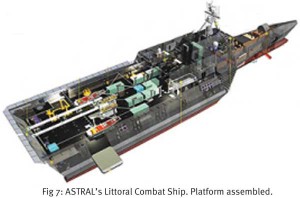 The use of a CBC makes it exceptionally easy for the Navy to ensure Configuration Management when it has many ships of a single class. For least cost and optimum performance, it is absolutely essential that the Ships of a Class retain their initial similarity throughout their life. This can only be achieved if the standards, spares, maintenance and mid life refits are the same throughout the class. The use of a CBC makes that feasible. Without that, with time, every ship of a Class morphs into a stand alone Class of its own thus creating a series of escalating logistic problems which in peace time get swept under the rug but invariably later, under action conditions, get exposed.
The use of a CBC makes it exceptionally easy for the Navy to ensure Configuration Management when it has many ships of a single class. For least cost and optimum performance, it is absolutely essential that the Ships of a Class retain their initial similarity throughout their life. This can only be achieved if the standards, spares, maintenance and mid life refits are the same throughout the class. The use of a CBC makes that feasible. Without that, with time, every ship of a Class morphs into a stand alone Class of its own thus creating a series of escalating logistic problems which in peace time get swept under the rug but invariably later, under action conditions, get exposed.
From time to time, many expressions pertinent to Modular design have been used by the Shipbuilding Industry. Some of these are listed below to enable readers to have a better appreciation of what they represent:
- Payload limited: The payload which are the Weapons & Command and Control will be Modular based without any size restriction but limited to a chosen Platform.
- Payload volume limited: The payloads Modules are additionally restricted to a particular volumetric size (Containers) to facilitate quick interchange between ships whilst maintaining cross Platform commonality.
- All systems: Every system on the Platform will be Modular based; some may even be volume limited. This would result in the lowest maintenance costs and building time whilst stimulating competition among the system specialists.
- Function segregated: All systems pertaining to individual main functions are Modular but distinctly and strictly segregated into sequential blocks like Oilers and Bulk carriers. The ship then mainly consists of segments; each segment with a specific functions like seen in nature. With the recent break through in super-conductivity, a function segregated, segmented all Electric Destroyer is now feasible. It is a trend that is gaining momentum.
- Reserve capacity: Often a choice has also to be also made if the design is to have reserve allowances. Reserve capacity required at the Platform level could be reserve wire way capacity, reserve pipe bank capacity and the ability to accommodate an added parallel mid body block in an alternate version, etc. Reserves at the Module level have to be fully detailed in one or more of the interface specifications and these could include areas, volumes, power and other services which have to be provided for to handle any technology refuels and even half life updates.
There are also other fundamental questions that must be addressed if the full benefits of Modular design are to be realized: These are set out below:
- Is the Architecture of the Platform and its systems to be open based or closed? This single decision will have the biggest impact on cost and time. Most politicians, and bureaucrats have little understanding of this very important parameter that affects costs. Open systems are systems that rely on technologies that are currently in use in the Industry. Closed systems are systems specifically designed for the client. It is a fact that Open systems encourage better competition, a faster rate of improvements and the cheapest end products. This is a fundamental question which must be addressed prior to formulating other details. The trend is towards the use of Open systems since full shock hardening to realistically meet the shock load spectrum of modern weapons can be economically overwhelming. As the shock intensity of weapons has grown by leaps and bounds, the shock spectrum used by most designers is most often out dated for the weapons now in use. This is especially so when it takes a decade between keel laying and delivery. Actual correlation and deficiencies can only be established by extensive trials on a shock range and analysis of survival from current battle conditions at time of delivery. It often makes no sense to excessively proof harden some particular equipment when statistics indicates platform survival in battle is increasingly low.
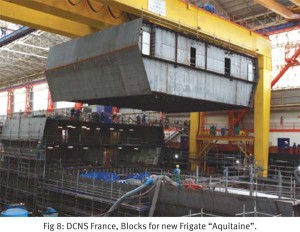 In service Technical Divisions invariably increase the costs of Capital projects by making unwarranted and unrealistic demands in specifications tailored by them. Managers in Industry are then quick to turn such demands into extravagant cost overruns. The old monopolies created by closed systems are not easy to replace. Being very lucrative, they have a very strong in house and an external lobby support base. The choice has to be a client based decision and not one that can be decided by the designer. Huge savings can be made by intelligent and valued use of open systems.
In service Technical Divisions invariably increase the costs of Capital projects by making unwarranted and unrealistic demands in specifications tailored by them. Managers in Industry are then quick to turn such demands into extravagant cost overruns. The old monopolies created by closed systems are not easy to replace. Being very lucrative, they have a very strong in house and an external lobby support base. The choice has to be a client based decision and not one that can be decided by the designer. Huge savings can be made by intelligent and valued use of open systems.
- Will the ship procurement be single sourced (a single Builder) or Group sourced to a consortium? A consortium must include separated and distinct expertise in Project Management, design, test facilities, specialist Module/Block building and assembly of the different Blocks/Modules. A group sourced procurement will be the fastest and will encourage development of system oriented Module builders because of direct participation. It decouples the ship, system design and their production whilst reducing the cost of maintenance, technology refreshes and half life updates. It is the preferred route.
- Can the specialist Module builders build, handle and store their associated steel work under covered conditions and assemble incoming modules into Blocks? This is most desirable as it means less time spent in fabrication and installation at the Assembly yard. Tests, trials and inspection related to the Module and the associated Hull can then be carried out prior to its shipment to the Assembly yard.
- What is the largest Block size that they can safely handle? The larger the size, the less is the time spent in the Assembly yard. Unnecessary delays occur due to misalignment of adjacent Blocks, incomplete interfaces and poor Q.A. In the world market, current Block sizes are +2000 Tons for a Cape Ore, +1000 Tons for Carriers and +600 Tons for smaller ships. Blocks are steadily increasing in size. Assembly yards doing general steel construction have done crane barge lifts of 11,600 Tons representing Bridge/Platform sections destined for large infrastructure projects.
- How will the inspections, tests and trials including thermal testing, noise, vibration test, sonar ranging, Radar imaging, I.R and shock testing be conducted by the Module builders? The evaluation of all such facilities and their established performance must be established and documented by an independent Technical audit prior to any project.
- What is the capacity of the Assembly yard to assemble and safely store and maintain incoming Modules/Blocks and also build non specialist ones?
- How will the tests, trials and inspections of the finished Platform (similar to those above for a module) be conducted and by whom? This is best undertaken by the Project Team who must always have the final say. The comments in respect of Module trials above are also applicable for the Platform. Public release of actual trial data based entirely on ratios indexed to unit coefficients ascribed to the targets in the Statement of requirements helps to establish the credibility of the many claims often made by designers/builders and the superlatives that usually follow. To-date, such information together with total life cycle costs is not freely available.
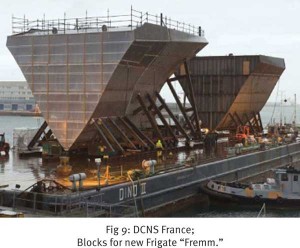 The capacity of the specialist Module builders are easily established by doing a functional analysis of the ship and its systems, evaluating the suppliers available and their past performance to build similar modules. In addition to assessing their technical competence for the particular system, they should have adequate covered shop facilities, handling and lifting arrangements to build, handle and store the largest Block size or Module they wish to build. The transport /handling storage, launching and berthing arrangements at such Module/Block Builders and the Assembly yard under extreme conditions including the hundred year seismic and environmental load spectrums at each site needs to be carefully evaluated and signed off by the Underwriters for the maximum size, berthing, launch-ways, trigger loads on dagger foundations, erection loads and the lifts envisioned. At public enquiries after an incident, it has been my experience that most of these records are never found possibly because they never existed in the first place. An evaluation of the 3-D security and firefighting capacity at each site is also necessary to complete the assessment.
The capacity of the specialist Module builders are easily established by doing a functional analysis of the ship and its systems, evaluating the suppliers available and their past performance to build similar modules. In addition to assessing their technical competence for the particular system, they should have adequate covered shop facilities, handling and lifting arrangements to build, handle and store the largest Block size or Module they wish to build. The transport /handling storage, launching and berthing arrangements at such Module/Block Builders and the Assembly yard under extreme conditions including the hundred year seismic and environmental load spectrums at each site needs to be carefully evaluated and signed off by the Underwriters for the maximum size, berthing, launch-ways, trigger loads on dagger foundations, erection loads and the lifts envisioned. At public enquiries after an incident, it has been my experience that most of these records are never found possibly because they never existed in the first place. An evaluation of the 3-D security and firefighting capacity at each site is also necessary to complete the assessment.
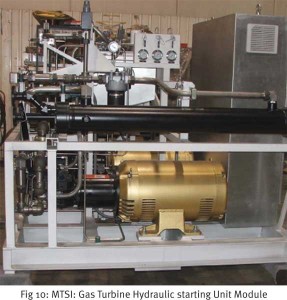 Warships are getting progressively more expensive to build, operate and maintain. Their payloads are becoming redundant ever faster. Economic conditions demand that Navies change their ship acquisition strategies. The new generation of ships will need quick reconfiguration for multi mission tasking as opposed to being designed for a fixed single mission. Additionally, they will have to be cheaper with shorter delivery times. Modular designed ships also require smaller crews and are maintenance friendly. On the down side, they will be larger and slightly heavier than conventional frame designed ships.
Warships are getting progressively more expensive to build, operate and maintain. Their payloads are becoming redundant ever faster. Economic conditions demand that Navies change their ship acquisition strategies. The new generation of ships will need quick reconfiguration for multi mission tasking as opposed to being designed for a fixed single mission. Additionally, they will have to be cheaper with shorter delivery times. Modular designed ships also require smaller crews and are maintenance friendly. On the down side, they will be larger and slightly heavier than conventional frame designed ships.
The current procedural arrangements within our existing Shipbuilding Industry and their many suppliers are not suited to fast Modular design and Construction. The intrinsic speed and interdependency required for faster construction require a different skill set, tools and incentives. In addition, the existing education and training spectrum within the Industry is a very narrow band one; heavily biased towards highly segregated disciplines which is inadequate for Modular design and assembly. That spectrum needs to change to a Module based wide band with much higher minimum standards extending to the lowest grades. Personnel especially designers and suppliers need to be very conversant and understand the science involved in every ship system and shipyard process. The advantages of the Private sector over the Public sector in terms of productivity and costs are well known. This acceptance has now been confirmed by an established shift of political emphasis to the former. Disruptive technologies and innovations often decide the outcomes of wars. Individual entrepreneurs historically have a better track record of such deliveries and risk acceptance than the public sector. To establish the precise benefits of any reorganization and introduction of new methodology, the true costs of existing Ships needs to be carefully established. Those costs must also include the direct and indirect expenditures incurred by associated Departments including Research & Development, Design Bureaus, Production, Training, Overseeing etc.
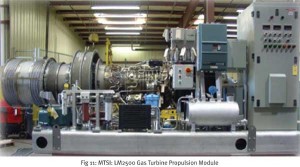 The Shipbuilding Industry and the associated R&D Organizations are in need of a major renaissance and reformation led by young dynamic and innovative professionals who can think boldly and act beyond the conventional box. Like Lego sets, the next generation of ships designs can be reconfigured for new missions within weeks and even assembled if the modules are correctly designed, pre-built and available at selected locations. It is hoped that this presentation will provide the necessary stimulus to senior echelons to initiate the necessary in depth review of the Industry in order to establish on a rational basis the Modular design and production of the ships the Navy needs.
The Shipbuilding Industry and the associated R&D Organizations are in need of a major renaissance and reformation led by young dynamic and innovative professionals who can think boldly and act beyond the conventional box. Like Lego sets, the next generation of ships designs can be reconfigured for new missions within weeks and even assembled if the modules are correctly designed, pre-built and available at selected locations. It is hoped that this presentation will provide the necessary stimulus to senior echelons to initiate the necessary in depth review of the Industry in order to establish on a rational basis the Modular design and production of the ships the Navy needs.




